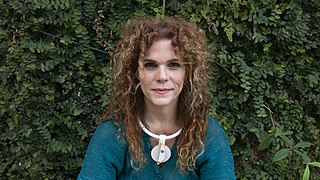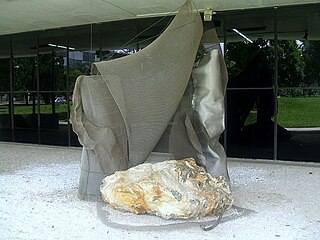Brígida Baltar was a Brazilian visual artist. Her work spanned across a wide range of mediums, including video, performance, installation, drawing, and sculpture. She was interested in capturing the ephemeral in her artwork.

Héctor Julio Páride Bernabó was an Argentine-Brazilian artist, researcher, writer, historian and journalist. His nickname and artistic name, Carybé, a type of piranha, comes from his time in the scouts. He died of heart failure after the meeting of a candomblé community's lay board of directors, the Cruz Santa Opô Afonjá Society, of which he was a member.

The Centro Cultural Banco do Brasil is a cultural organization of the Bank of Brazil based in Brazil with centers in Belo Horizonte, Brasília, Rio de Janeiro and São Paulo.
Frida Baranek is a Brazilian sculptor known for creating large sculptural works that incorporate fibers and industrial materials such as plates, rods, and iron or steel wires as commentary on industrialization and the environment in Brazil.

Fayga Perla Ostrower was a Polish-Brazilian engraver, painter, designer, illustrator, art theorist and university professor.

Laura Lima is a contemporary Brazilian artist who lives and works in Rio de Janeiro. Since the 1990s, Lima has discussed in her works the matter of alive beings, among other topics. Her works can be found in the collections of institutions such as Bonniers Konsthall, Stockholm, Sweden; Inhotim Institute, Brumadinho, Brazil; MAM - Museum of Modern Art, São Paulo, Brazil; Migros Museum für Gegenwartskunst, Zurich, Switzerland; Pinacoteca of the State of São Paulo, Brazil; Itaú Cultural, São Paulo, Brazil; Pampulha Museum of Art, Belo Horizonte, Brazil; National Museum of Fine Arts, Rio de Janeiro, Brazil; Hammer Museum, Los Angeles, USA; MASP - Museum of Art of São Paulo, Brazil, among others.
Anna Maria Maiolino is a Brazilian contemporary artist.

Iole Antunes de Freitas is a Brazilian sculptor, engraver, and installation artist who works in the field of contemporary art. Freitas began her career in the 1970s, participating in a group of artists in Milan, Italy linked to Body art. She used photography. In the 1980s, she returned to Brazil, but abandoned the human body as mediator of her work, adopting the "sculpture body". The artist uses materials such as wire, canvas, steel, copper, stone, and water to create her works.
Waltércio Caldas Júnior, also known as Waltércio Caldas, is a Brazilian sculptor, designer, and graphic artist. Caldas is best known as part of Brazil's Neo-Concretism movement as well as for his eclectic choices in materials.
Maria Lynch Rio de Janeiro born 1981 is a Brazilian artist
Gisele Camargo was born on July 11, 1970, in Rio de Janeiro, Brazil. She is a Brazilian painter and photographer who works in photography, video, and painting. She is best known for her pictorial meditations on urban and cinematic landscapes. She was formally trained at the Escola de Belas-Artes (EBA) of the Universidade Federal do Rio de Janeiro in the late 1990s. While in the institution, Camargo was part of a group of students who concentrated on issues of urban experience and visual culture in Rio de Janeiro. Camargo was different from the rest of her classmates, while they engaged mostly with multimedia language she remained a painter, with sporadic forays into photography and photocollage.

Rosângela Rennó Gomes is a Brazilian artist who lives and works in Rio de Janeiro. Her work consists of photographic images from public and private archives that question the nature of an image and its symbolic value. With the use of photographs, installations and objects, she appropriates and sheds new light on an anonymous body of photographs and negatives found mostly in flea markets, family albums, newspapers and archives. Rennó's interest in discarded images and habit of collecting were decisive in establishing her work strategies.
PIPA Prize is a Brazilian arts award of the PIPA Institute. From 2010 to 2018, PIPA had a partnership with the Museum of Modern Art of Rio de Janeiro – MAM-Rio. In 2019, the PIPA Prize's exhibition was held at Villa Aymoré, in Rio de Janeiro, Brazil.
Tatiana Blass is a Brazilian artist that constructs complex abstract narratives with her performances, paintings, videos, and installations.

Alice Miceli is a Brazilian artist. She lives and works in Rio de Janeiro and New York.
Renata Lucas is a Brazilian artist.

Paulo Nazareth is a Brazilian contemporary artist based in Belo Horizonte, Brazil. Nazareth has achieved notable acclaim for his distinctive approach to contemporary art, exemplified by multimedia, performance-based works, international exhibitions, and prestigious awards such as the PIPA Prize, solidifying his status as an influential figure in the global art scene.

Eli Heil (1929–2017) was a Brazilian painter, sculptor, ceramicist, tapestry maker and poet. She exhibited on numerous occasions in Brazil and abroad.
Mariannita Luzzati is a Brazilian visual artist from São Paulo, recognized for her extensive study of landscapes.
Tikashi Fukushima was a Japanese-Brazilian painter and printmaker. Considered one of the most important abstractionists in Brazil, Fukushima also produced several works in the field of figurativism throughout his career. The artist has received various positive reviews from numerous important art critics for both his abstractionist and figurative productions. Fukushima belongs to the pre-war immigrant generation, composed of common immigrants who, after several changes in their lives, awakened to the arts. His master was Tadashi Kaminagai, whom Fukushima saw as a mentor, but who had a different style of painting than the one he later developed. Tikashi's works have been presented in national and international exhibitions.








